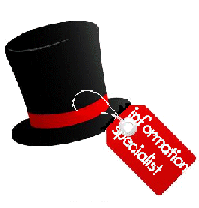The second hat that the teacher librarian wears is that of information specialist.
According to Learning for the Future (2nd edition) (ASLA & ALIA, 2001), this means we provide
access to information resources through efficient and well-guided systems for organising, retrieving and circulating resources and training and assistance to students and staff in the effective use of these systems
In the past, that was a relatively simple assignment – fiction resources were split into two sections, either picture books or novels, and given a classification based on the author’s name; non fiction was classified and shelved according to the Dewey Decimal Classification system. Students were taught now to use the catalog, how the Dewey system worked so they could make sense of the numbers and then expected to locate the required resources on the shelves.
But the rapid development of technology has changed the goalposts and now, instead of staff and students coming to the information, in many situations the TL takes the information to the students. Thus, as well as having an efficient, up-to-date catalog we need to know how to create and use hotlists, databases, social media, content management systems, virtual learning environments and a host of other tools so we can provide efficient and equitable access to the resources 365/24/7. No longer is the library confined by walls and clocks.
There is also a push to abandon the traditional arrangements of the library so they become more like bookstores – the titles arranged by genre rather than author or subject. From time to time, this issue is discussed on the TL networks around the world, and Jan Radford has collated a range of articles here. Other changes include arrangement by reading level particularly those assigned by commercial programs, or making special collections such as those for the LGBTI students.
However, before any such change is considered, there is a range of questions that need to be asked and answered with acceptable, independent evidence.
Given that the definition of being the information specialist is based on providing efficient and effective access to resources, then we must demonstrate that any changes will do this better than what is offered now. So we need to consider…
-
- Why is the change being considered?
- Is this a sound reason for change?
- Why is what is currently in place not working? What is the evidence that it is not? How can it be changed/ modified to work rather than introducing a non-standard ‘fix’?
- Is the solution based on sound pedagogical reasons whose efficacy can be measured?
- What reliable evidence (apart from circulation figures) exists to support the changes and demonstrates improvement to student learning outcomes?
- How will the change support the Students’ Bill of Rights?
- Have students had input into the proposal?
- Will the proposed changes lead to students being more independent, effective and efficient users of the library’s resources?
- Will the change marginalise or discriminate against any users such as identifying their below-average reading level or sexual preferences?
- Will the change broaden or narrow the students access to choices and resources?
- Is it based on school-library best practice? Are there successful models (measured through action research and benchmarks and published in reliable authoritative literature) that demonstrate that this is a sustainable, effective and efficient model to emulate?
- Will the change make it easier to achieve your mission statement and your vision statement?
- How do the changes fit within your library policy, which, presumably, has been ratified by the school’s executive and council? Will the change in procedure require a change in policy?
- Who is responsible for developing the parameters of the change and documenting the new procedures to ensure consistency across time and personnel?
- If a change is made, what S.M.A.R.T. goals will be set to measure its impact?
- Who will do the measuring and ensure that the conclusion is independent and unbiased?
- If those goals show no change or a decline, will the library be willing to reverse the process? Will this be a practical proposition?
- How will the proposed change impact on the role and workload of the teacher librarian?
- How will the proposed change impact on the role and workload of other library staff?
- If the change changes the traditional library arrangement, how is consistency across time guaranteed if personnel change because decisions are subjective?
- Who is responsible for developing and maintaining the criteria for placement and the Procedures Manual to ensure consistency?
- Is the change worth the time that is invested in re-classifying every title and the money invested in new labels, staff wages etc?
- Could that time and money be better spent?
- Would better signage, including more shelf dividers, address the problem?
- What role can displays play in highlighting different and unfamiliar resources to broaden access and choices?
Library 2.0 means that Librarian 2.0 keeps changing and we need to continually monitor and modify the shape and the fit of this hat.

